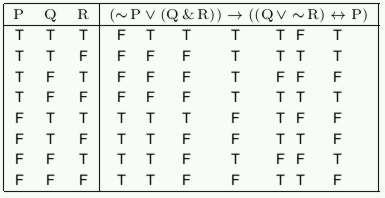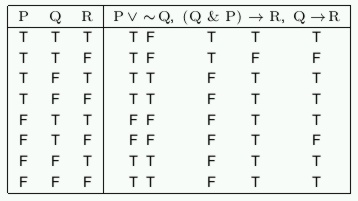| It is widely known that |
|
| T | ? |
| F | F |
Definition: A truth table for a connective * is a table that displays how the truth value of a sentence whose main connective is * is determined by the truth values of its immediate sentential components.
Definition: A connective * is truth functional if the truth value of any sentence whose main connective is * is completely determined by the truth values of its immediate sentential components.
Comment: We are only interested in constructing truth tables for connectives that are truth functional .
Example: ``It is widely known
that'' is not truth functional
| It is widely known that |
|
| T | ? |
| F | F |
Comment: All of the
connectives introduced in Chapter 1 are truth functional.
| T | F |
| F | T |
Comment: in order
for a negation ![]() to be true,
to be true, ![]() must be false; and for
must be false; and for ![]() to be false,
to be false, ![]() must be true.
must be true.
| T | T | T |
| T | F | F |
| F | T | F |
| F | F | F |
Comment: In order
for a conjunction ![]() to be true, both
to be true, both ![]() and
and ![]() must both be true. Otherwise
must both be true. Otherwise ![]() is false.
is false.
| T | T | T |
| T | F | T |
| F | T | T |
| F | F | F |
Comment: In order
for a disjunction ![]() to
be true, either
to
be true, either ![]() or
or ![]() (possibly both) must be true. Thus,
(possibly both) must be true. Thus, ![]() is false if and only if both
is false if and only if both ![]() and
and ![]() are false.
are false.
| T | T | T |
| T | F | F |
| F | T | T |
| F | F | T |
Comment: In order
for a conditional ![]() to
be true, either
to
be true, either ![]() must be false or
must be false or ![]() must be true. Thus,
must be true. Thus, ![]() is false if and only if
is false if and only if ![]() is
true and
is
true and ![]() is false.
is false.
Comment: If the antecedent ![]() of a conditional
of a conditional ![]() it false, then
it false, then ![]() is
true regardless of the truth value of
is
true regardless of the truth value of ![]() .
Similarly, if the consequent
.
Similarly, if the consequent ![]() is true, then
is true, then ![]() is true regardless of the truth value of
is true regardless of the truth value of ![]() .
(Cp. the derived rules False Antecedent (
.
(Cp. the derived rules False Antecedent (![]() )
and True Consequent (
)
and True Consequent (![]() ).
).
| T | T | T |
| T | F | F |
| F | T | F |
| F | F | T |
Comment: In order
for a biconditional ![]() to
be true,
to
be true, ![]() and
and ![]() must have the same truth value, i.e., either both
must have the same truth value, i.e., either both ![]() and
and ![]() are true or both are false. Otherwise,
are true or both are false. Otherwise, ![]() is false.
is false.
Definition: A truth table for a sentence ![]() is a table that displays how the truth value of
is a table that displays how the truth value of ![]() is determined by the truth values of its constituent sentence letters.
is determined by the truth values of its constituent sentence letters.
Comment: The truth
table for any sentence ![]() is
constructed in accordance with the truth tables for connectives, starting
with the smallest sub-sentences of
is
constructed in accordance with the truth tables for connectives, starting
with the smallest sub-sentences of ![]() (i.e., the ones whose immediate sentential components are sentence letters)
and working ``upwards''. The column for a given component of a sentence
(other than the sentence letters) is placed under that component's main
connective.
(i.e., the ones whose immediate sentential components are sentence letters)
and working ``upwards''. The column for a given component of a sentence
(other than the sentence letters) is placed under that component's main
connective.
Example

Comment: If a sentence contains n distinct constituent sentence letters (types, not tokens), then there are 2n rows in its truth table.
Definition: A sentence ![]() in given a truth table is said to be true on a row of the truth
table if a T occurs below its main connective on that row. Otherwise it
is said to be false on that row.
in given a truth table is said to be true on a row of the truth
table if a T occurs below its main connective on that row. Otherwise it
is said to be false on that row.
Example

Definition: A truth value assignment for a set
of sentences ![]() is an assignment of a single truth value to each constituent sentence letter
occurring in the sentences
is an assignment of a single truth value to each constituent sentence letter
occurring in the sentences ![]() ,
...,
,
..., ![]() (and
possibly also to other sentence letters as well).
(and
possibly also to other sentence letters as well).
Comment: If n=1,
i.e., for singleton sets ![]() ,we
will usually just talk about truth value assignments for the sentence
,we
will usually just talk about truth value assignments for the sentence ![]() rather
than the set singleton set
rather
than the set singleton set ![]() .
.
Comment: Each row
of a truth table for a set of sentences ![]() corresponds to a truth value assignment for that set. Furthermore, every
(relevant) truth value assignment for the set is represented by some row
of the truth table for the set.
corresponds to a truth value assignment for that set. Furthermore, every
(relevant) truth value assignment for the set is represented by some row
of the truth table for the set.
Comment: We will occasionally
indicate a truth value assignment for a sentence (e.g., in the QuizMaster)
with the notation ![]() sentence
letter
sentence
letter![]() :
: ![]() truth
value
truth
value![]() .
So, e.g., the truth value assignment assigning T to P
and Q and F to R
would be indicated in this manner by P:T
Q:T R:F.
.
So, e.g., the truth value assignment assigning T to P
and Q and F to R
would be indicated in this manner by P:T
Q:T R:F.
Definition: A sentence ![]() is said to be true on a given truth value assignment if it is true
on the the row corresponding to that assignment in the truth table for
is said to be true on a given truth value assignment if it is true
on the the row corresponding to that assignment in the truth table for ![]() .
.